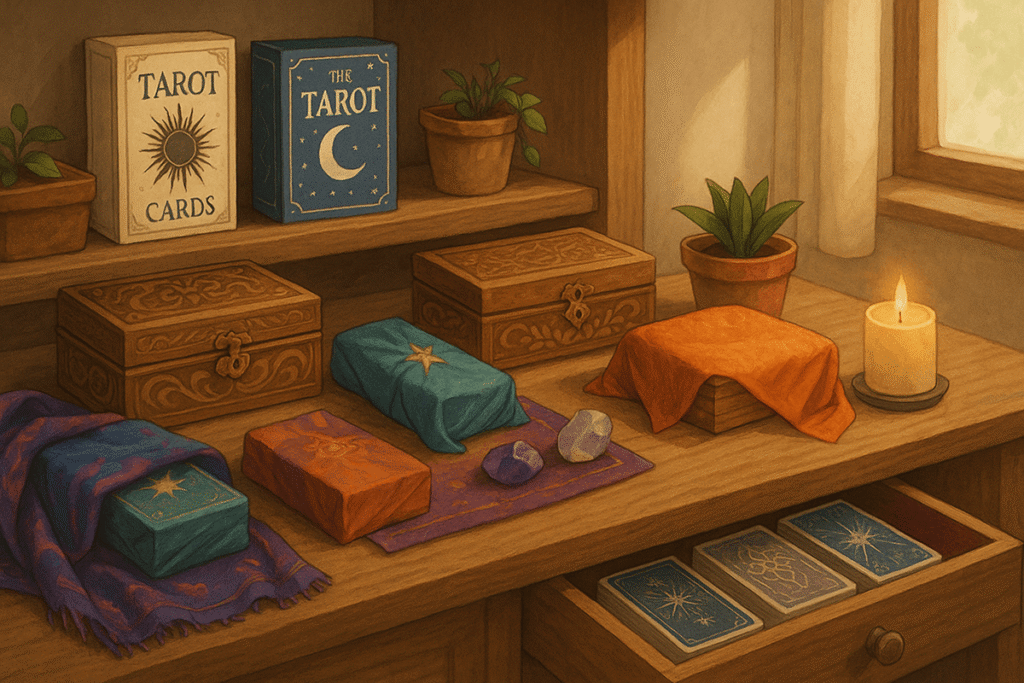Table of Contents
Your tarot deck collection deserves more than being scattered across your nightstand or stuffed into random drawers. Perhaps you’ve noticed how the cards seem to respond differently when they’re cared for properly. I think there’s something meaningful about creating dedicated spaces for the tools we use in our personal reflection practice.
The way we store our tarot decks reflects not just practical needs, but also our relationship with these intricate pieces of art and symbolism. Whether you own a single beloved deck or dozens of different sets, finding the right storage approach can enhance both the longevity of your cards and your connection to them.
Why Proper Storage Matters for Your Cards
Tarot cards face more wear and tear than you might initially realize. The oils from our hands, dust particles, moisture in the air, and even sunlight can gradually damage the delicate cardstock and artwork. I’ve seen beautiful vintage decks lose their vibrancy simply from being left exposed to light for extended periods.
Temperature fluctuations create another challenge. Cards expand and contract with changes in humidity, which can lead to warping or separation of the card layers. This is particularly true for decks with metallic finishes or specialty printing techniques.
Beyond the physical protection, many readers find that thoughtful storage enhances their connection to their decks. There’s something about the ritual of carefully placing cards in their designated space that signals respect for both the artistic work and the personal practice they support.
The storage method you choose might influence how often you reach for a particular deck. Decks stored in easily accessible places tend to get more use, while those buried in boxes often get forgotten. This isn’t necessarily good or bad, just something to consider as you plan your storage approach.
Traditional Storage Methods That Work
The original tuck box that comes with most tarot decks serves as a perfectly adequate starting point. These cardboard containers protect against dust and light exposure while keeping cards organized. However, frequent use can cause these boxes to wear down relatively quickly.
Many readers upgrade to sturdier alternatives while keeping their original boxes as backup storage. Wooden boxes offer exceptional durability and often develop a beautiful patina over time. Cedar boxes provide natural moth and moisture resistance, though some people find the scent too strong for their taste.
Vintage cigar boxes make excellent tarot storage containers. Their size usually accommodates standard tarot decks perfectly, and the craftsmanship often exceeds what you’d find in purpose built storage solutions. Plus, there’s something appealing about repurposing these beautiful containers for a new function.
Small jewelry boxes with multiple compartments work well for readers who like to separate different types of cards or store accessories alongside their decks. You might keep crystals, small notebooks, or reference cards in the extra spaces.
Creative DIY Storage Solutions
Crafting your own storage solutions allows for complete customization and often costs less than purchasing ready made options. Fabric pouches sewn from velvet, silk, or cotton create soft, protective environments for your cards. The texture of different fabrics can add a sensory element to your practice.
Decorative tins originally designed for tea, cookies, or candies often work beautifully for tarot storage. I’ve found that tins with tight fitting lids provide excellent protection from moisture and dust. The artwork on vintage tins sometimes complements tarot imagery in unexpected ways.
Wooden wine boxes, available from many liquor stores for little or no cost, can be transformed into elegant tarot storage with some basic crafting supplies. A coat of stain or paint, some felt lining, and perhaps a small latch create a storage solution that rivals expensive commercial options.
Book safes, whether purchased or crafted from old hardcover books, offer discrete storage that doubles as interesting decor. This approach works particularly well if you prefer to keep your tarot practice private or simply enjoy the aesthetic of hidden compartments.
Fabric Wraps and Soft Storage Options
Silk scarves provide one of the most traditional and elegant ways to wrap individual tarot decks. The smooth texture protects card surfaces from scratching, while silk’s natural properties help regulate moisture. Many readers develop personal rituals around wrapping and unwrapping their cards, finding the process meditative.
Linen cloths offer similar protection with a different texture and feel. Some people prefer the slightly rougher weave of linen, finding it more grounding or earthy. Linen also tends to be more durable than silk, making it practical for frequently used decks.
Velvet pouches create a luxurious storage experience while providing excellent protection. The deep pile of velvet cushions the cards and prevents them from sliding around. However, velvet can attract dust and pet hair more readily than smoother fabrics.
Cotton wraps offer the most practical fabric option. They’re easy to clean, affordable, and available in countless colors and patterns. Many readers enjoy having different colored wraps for different decks, perhaps choosing colors that reflect the deck’s energy or intended use.
Displaying Your Collection
Some tarot decks are simply too beautiful to hide away completely. Display storage solutions let you enjoy your collection as art while still providing protection. Shallow wooden boxes with glass or acrylic tops create museum like presentations for special decks.
Standing easels designed for small artwork can showcase individual cards or even entire decks fanned out attractively. This works particularly well for decks with stunning box art or cards you want to contemplate regularly.
Shadow boxes allow for creative arrangements that might include not just the deck, but also meaningful objects, photos, or artwork that relate to your practice. The depth of shadow boxes accommodates thicker items while keeping everything behind protective glass.
Floating shelves provide simple display options that don’t require specialized containers. However, decks displayed this way need more frequent dusting and should be positioned away from direct sunlight to prevent fading.
Protecting Vintage and Special Edition Decks
Older decks and limited edition sets require extra consideration due to their potential value and irreplaceable nature. Acid free storage materials prevent chemical reactions that can yellow or deteriorate cardstock over time. Museum quality storage supplies, while more expensive, provide the best long term protection.
Climate controlled environments matter most for vintage decks. Basements and attics, with their temperature and humidity fluctuations, should be avoided. Interior closets or climate controlled storage areas provide more stable conditions.
Some collectors use archival plastic sleeves for individual cards in particularly valuable decks. While this offers maximum protection, it can make the cards less pleasant to handle during actual use. Consider whether a deck serves primarily as a collectible or a working tool when deciding on this level of protection.
Documentation becomes important for valuable decks. Photographs of the condition when acquired, notes about any existing damage, and records of storage conditions can be valuable for insurance purposes or future sales.
Creating Sacred Storage Spaces
Many readers find that designating a specific area for tarot storage enhances their practice. This might be as simple as a dedicated drawer or as elaborate as a custom built cabinet. The key is intentionality in creating a space that feels respectful and purposeful.
Altar spaces naturally incorporate tarot storage, allowing decks to rest alongside other meaningful objects like crystals, candles, or photographs. The arrangement becomes part of the practice itself, with the act of selecting and returning decks serving as gentle rituals.
Some people prefer portable storage solutions that travel with them. A beautiful bag or case that holds multiple decks along with accessories like cloths, crystals, or notebooks allows for consistent practice regardless of location.
The storage area you choose might influence how you approach your tarot practice. Highly visible storage might encourage daily use, while more private storage can create a sense of special occasion around consulting the cards.
Organizing Multiple Decks
As collections grow, organization becomes increasingly important. Some readers group decks by theme or artistic style, while others organize by frequency of use. There’s no universally right approach, just what works for your particular needs and preferences.
Labeling systems help when collections become extensive. Small tags or cards identifying each deck can save time when you’re looking for something specific. Digital catalogs with photos can be helpful for very large collections.
Rotation systems ensure that all decks receive attention over time. Some readers keep a few decks easily accessible while storing others more permanently, swapping them periodically to rediscover forgotten favorites.
Consider the practical aspects of your storage system. Can you easily access any deck when inspiration strikes? Do you remember what you own, or do some decks disappear into storage limbo? The best organizational system is one you’ll actually use consistently.
Creating thoughtful storage solutions for your tarot decks serves multiple purposes. It protects your investment in these beautiful artistic works, creates rituals that enhance your practice, and demonstrates respect for the tools that support your personal reflection. Whether you choose simple fabric wraps or elaborate custom storage, the key is finding approaches that feel right for your particular collection and practice style.
Frequently Asked Questions
Should I keep my tarot cards in their original box?
The original cardboard boxes that come with most tarot decks work as temporary storage, but they tend to wear out quickly with frequent use since they’re made of thin paperboard that won’t withstand being opened repeatedly or jostled around. If you use your deck regularly, consider upgrading to a more durable storage option like a fabric pouch or wooden box, though you might want to keep the original packaging stored separately in case you ever want to trade or sell the deck.
What size bag or box do I need for standard tarot cards?
For a standard tarot deck, look for storage that measures at least 5 inches by 7 inches, and remember to account for the thickness of the deck by choosing containers that are at least two inches longer and wider than your cards. This extra room ensures the cards fit comfortably without being squeezed, which could cause warping or damage to the edges over time.
Is it better to store tarot cards flat or upright?
Cards should be stored flat rather than upright to help maintain their shape and prevent warping, and you should avoid stacking heavy items on top of them. Storing them horizontally, similar to how you’d lay a book flat on a table, reduces stress on the cardstock and helps prevent the cards from bending or curving.
Can I use both a bag and a box for storage?
Using both a fabric wrap or bag inside a box is actually an excellent way to preserve your cards, providing double protection against damage. This layered approach works particularly well for decks you don’t use frequently or for valuable vintage decks that need extra protection from dust, moisture, and physical impacts.







